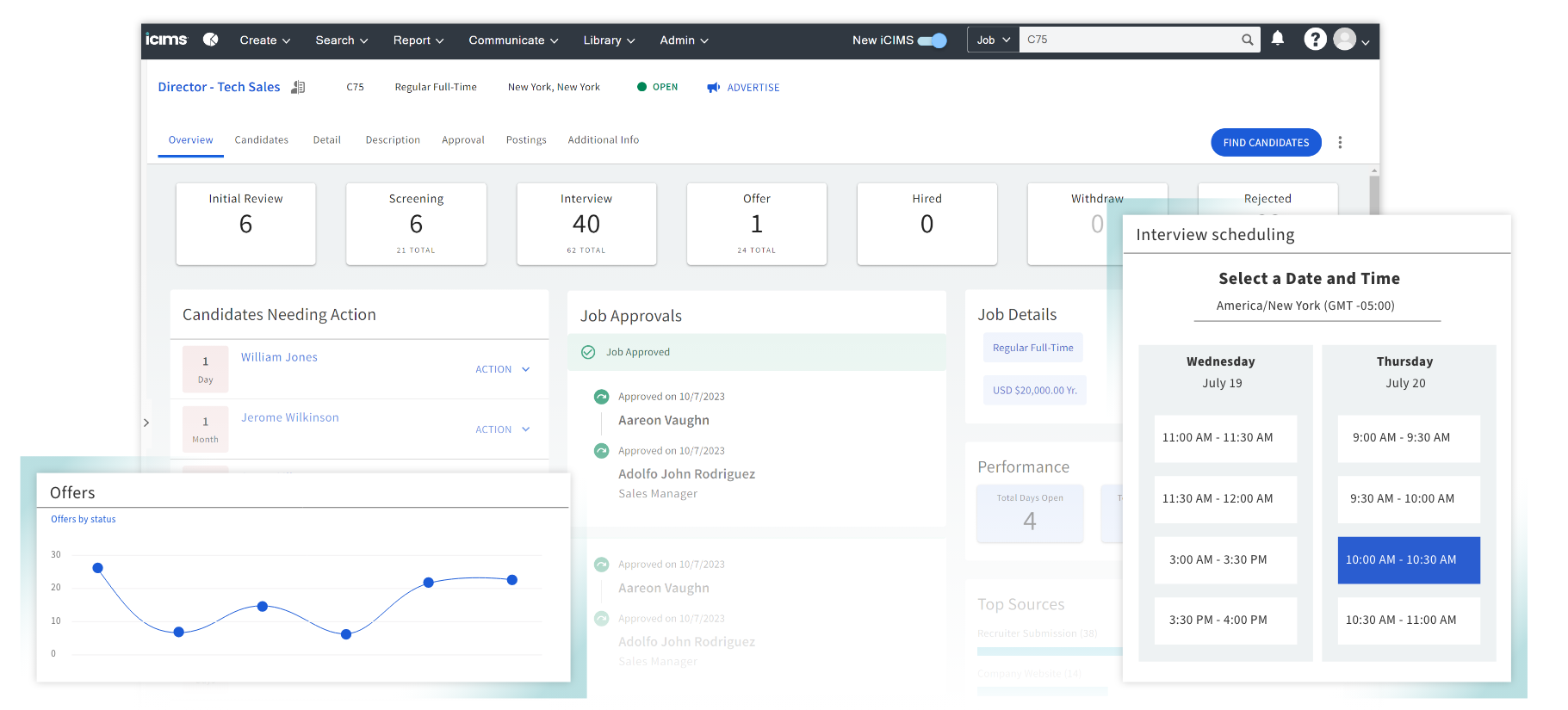

An applicant tracking system is a software application that helps recruiters manage the hiring process. The software allows a company to:
Most importantly, an ATS creates a single source of truth, as data in the ATS is synchronized for HR professionals across the entire company.
Most enterprise-level companies use an ATS to manage their hiring processes, but this software can help smaller companies streamline their recruiting efforts as well. The most basic applicant tracking systems simply store candidate information. However, advancements in the software have enabled companies to:
Applicant tracking systems don’t just replace outdated methods of attracting and managing job applications. Instead, they enhance the entire process from end-to-end, both for the candidate applying for the job and the recruiter searching for the right employee.
The ATS acts as a definitive system that houses all your recruiting data in a single location. It is accessible by users across your company. Most ATS solutions help with the following:
Today, some 73% of job seekers start their search on Google. This means your job postings must be optimized with keywords, accessibility, and proper web design. This gives them a better chance of showing up in relevant search queries, whether they are posted on your website, on a job board, or elsewhere.
With the right ATS, you’ll have tools that enable you to easily optimize all your job postings for organic search. This takes the guesswork out of search engine optimization (SEO), and you will not have to rely as much on digital ads to get your job postings in front of the right candidates.
Automation helps your team members become more productive by doing their menial tasks for them. An ATS should allow you to automatically post open jobs to social networks and job boards, so you don’t have to do so manually. According to one study, automation can save your team up to six weeks of work time per year by making their recruiting efforts more streamlined.
Candidates will communicate with your staff through various channels, including email, SMS, social media networks, and job boards. An ATS draws all these communications into a single system, making them easier to track and manage. This enables you to communicate with candidates at scale instead of having to switch between channels over and over.
Even if you use multiple calendar tools within your organization, an ATS can integrate all your scheduling into a single interface. Many ATS solutions even come with video conferencing tools, so you can schedule and interview candidates within the same system.
Files, spreadsheets, and on-premise software solutions can lead to contradictory and incorrect information, and it is almost impossible to synchronize data from various recruiting software on your own.
An ATS does just that: It takes data from all your channels and compiles it into a single source of truth, so there is no confusion or contradiction.
Data in your ATS is displayed on a customizable dashboard, showing users the numbers and metrics they most care about. For example, recruiters can set up their ATS dashboards to reflect their daily tasks and action items, while an executive’s dashboard can show bigger picture numbers like time to fill and total vacancies.
Some hiring channels are more effective than others. An ATS helps you eliminate the guesswork by aggregating important data points to a personalized dashboard. You can analyze specific metrics like cost per hire and measure the effectiveness of individual channels or job boards.
Ten of the most popular recruiting metrics include:
See our recruiting metrics glossary page for detailed explanations of how and why these are measured.
Employees are one of your best sources of quality and relevant candidates. Most will have worked for other companies and know of someone who might be a good fit based on their skills and prior work. Referrals can happen organically in an ad hoc way. However, an applicant tracking system formalizes referrals by giving recruiters the tools to organize and solicit employees’ suggestions.
Video interviews are a must when dealing with remote employees or applicants willing to relocate but who currently live far away. They can also be used as part of an extended screening process, after a phone screen but before an in-person interview. Some applicant tracking systems can help facilitate video interviews, including scheduling, automated communication, and task reminders.
Finding out whether a candidate possesses the required skills for a job is an integral part of the hiring process. While an applicant tracking system doesn’t conduct assessments itself, it can manage the process for you, ensuring recruiters, candidates, and assessment providers have the information they need when they need it.
Applicant tracking systems screen for keywords found in a candidate’s resume and supporting materials, including cover letters and responses to open-ended writing prompts. Candidates who include more relevant keywords based on their skills, experience, and understanding of the job they’re applying to will pass through screening and be ranked higher than those who include fewer keywords.
Today, a quality ATS does more than scan for keywords; it analyzes the substance of what’s there. Applicant tracking systems rank candidates based on criteria, including years of experience, the relevance of keywords, and prior role (previous experience as a manager or supervisor, for example). Recruiters can better decide where to put their time reviewing candidates based on the ATS’s rankings or choose to refine results further by weighing different keywords more heavily than others.
Over time, ATS technology has gotten a lot more sophisticated than it used to be. In the past, candidates could stuff their resumes with keywords and expect to stand out from the crowd. Some even went so far as to copy and paste job descriptions into their resumes and turn the font white so it would register with the ATS but be invisible to human readers. Additionally, some applicant tracking systems did not parse resumes well outside of Microsoft Word documents.
Today, most ATS vendors have fixed these tricks and read PDFs and other file types accurately. Some applicant tracking systems have also gotten better at interpreting keyword variations, similar phrases, and acronyms. They also allow for more formatting variations, including colored fonts and pictures. That said, as a general rule, it’s still best to advise candidates to keep the format of their resumes simple whenever possible.
It can be challenging for HR teams to successfully track and manage their applicants using outdated tools. On average, a single job posting will receive 118 applicants. That’s why so many recruiting teams now turn to an applicant tracking system (ATS) to manage all their applicants in a single location and introduce new efficiencies into their processes.
An ATS uses automation to eliminate manual tasks and save your recruiters valuable time. Instead of wasting their work hours on data entry, they can focus instead on vetting and communicating with viable candidates.
An ATS can find the best-matched candidates for a role without human input, which reduces instances of hiring bias. For example, you can configure your system to match candidates regardless of their race, gender, or nationality, focusing instead on their skills and experience.
Your system will automatically screen out applicants who are not ideal candidates, ensuring you do not hire any unqualified employees. More importantly, an ATS will help you find candidates who do meet the rigorous standards of your recruiting process.
Your ATS doesn’t just make the recruiting process easier: it helps you improve it yourself by generating, categorizing, and analyzing data. With the right information, you can focus on hiring channels that are effective and de-prioritize those that are not.
Candidates expect companies of all sizes to have a modernized hiring process. Using an ATS, you can ensure every applicant receives a timely response to their application and has a seamless experience with your company, whether they are eventually hired or not. This has become an important factor in recruiting as candidates can leave reviews of hiring processes on third party sites, and more than half of job seekers say they wouldn’t apply to a company with bad online reviews.
The applicant tracking system you choose should come with features that make the recruiting process easier, more organized, and more efficient. Best-in-class ATS solutions typically come with the following features:
Your system should be designed for the current generation of users, which means it must be available on preferred devices like smartphones, tablets, and laptops. A cloud-based ATS will enable you to synchronize data across your organization, and you won’t have to update your software manually as you would with an on-premise solution.
Pay attention to what the product team says when you ask about the tool’s capabilities. If you often hear, “It can’t do that,” it could indicate that you won’t get the capabilities you genuinely want. Furthermore, your implementation team should be available to you before, during, and after your ATS has been onboarded.
Long system downtime and slow updates are also red flags. Your system should be available when you need it, even if you need to access it outside of regular business hours. Furthermore, your ATS should be updated and improved regularly, not only so your product is improving, but also to ensure the highest levels of security.
You don’t have to settle for a below-average application tracking system.
iCIMS’ Applicant Tracking System is designed with candidates and HR teams in mind, helping users navigate the complex and challenging world of recruiting. The interface puts the most important aspects of recruiting front and center, creating a single source of truth for recruiting efforts across your entire organization.
Empower your teams with automated:
Communicate with candidates the way they prefer, whether it is through email, SMS, or on social media. By adding iCIMS’ Applicant Tracking System into your hiring workforce, you can empower your teams to save time and find the best candidates across the most viable channels.